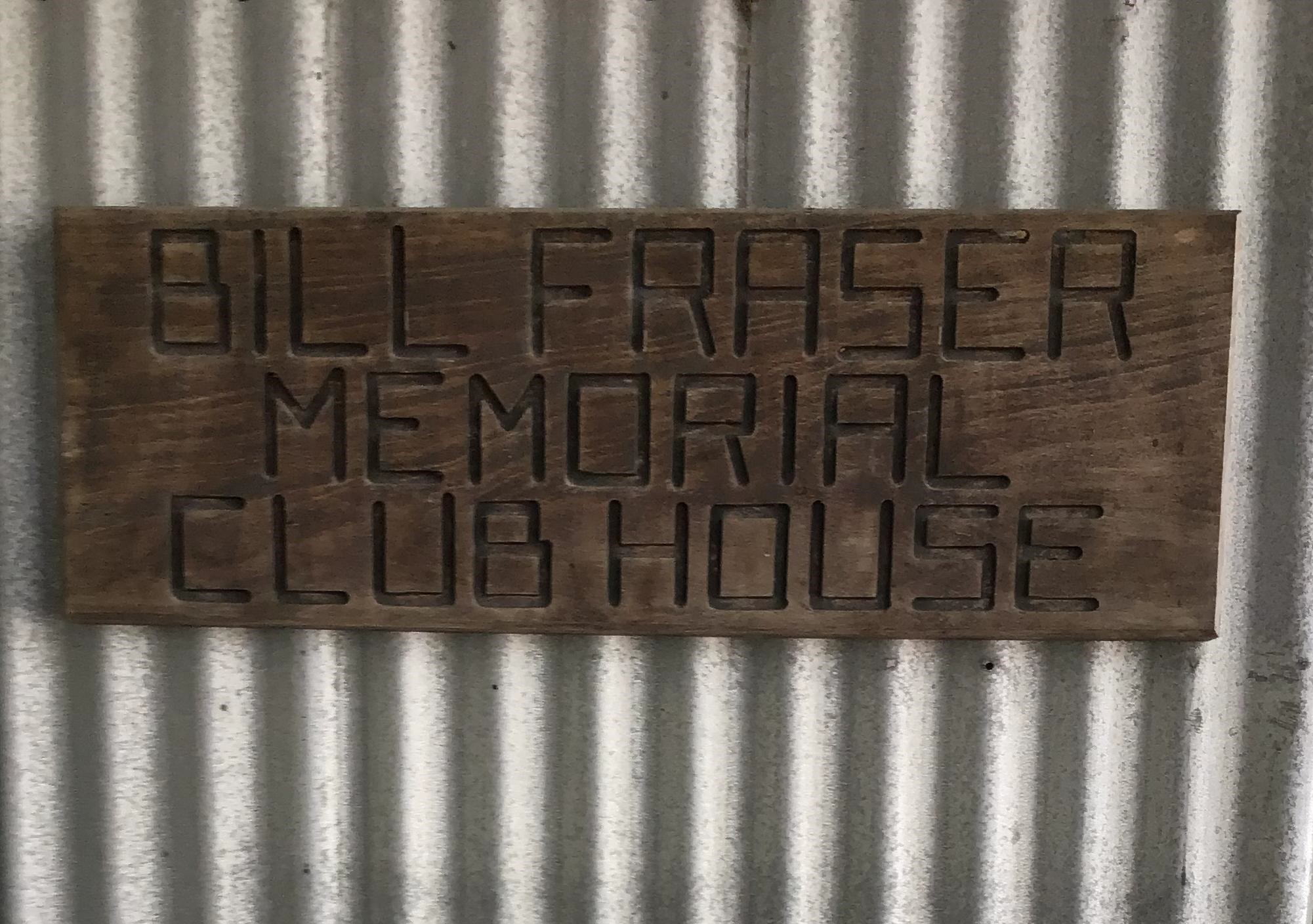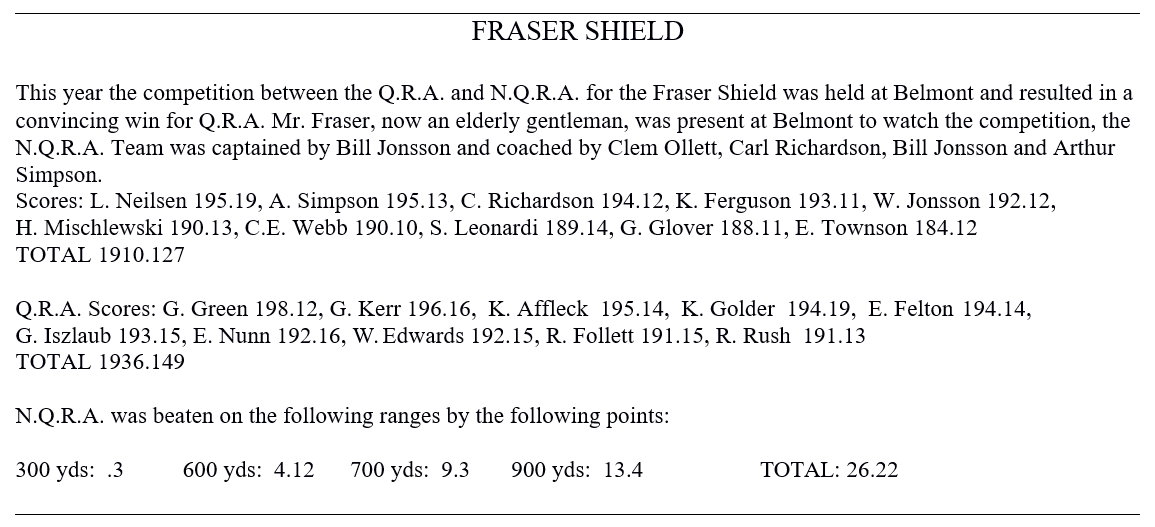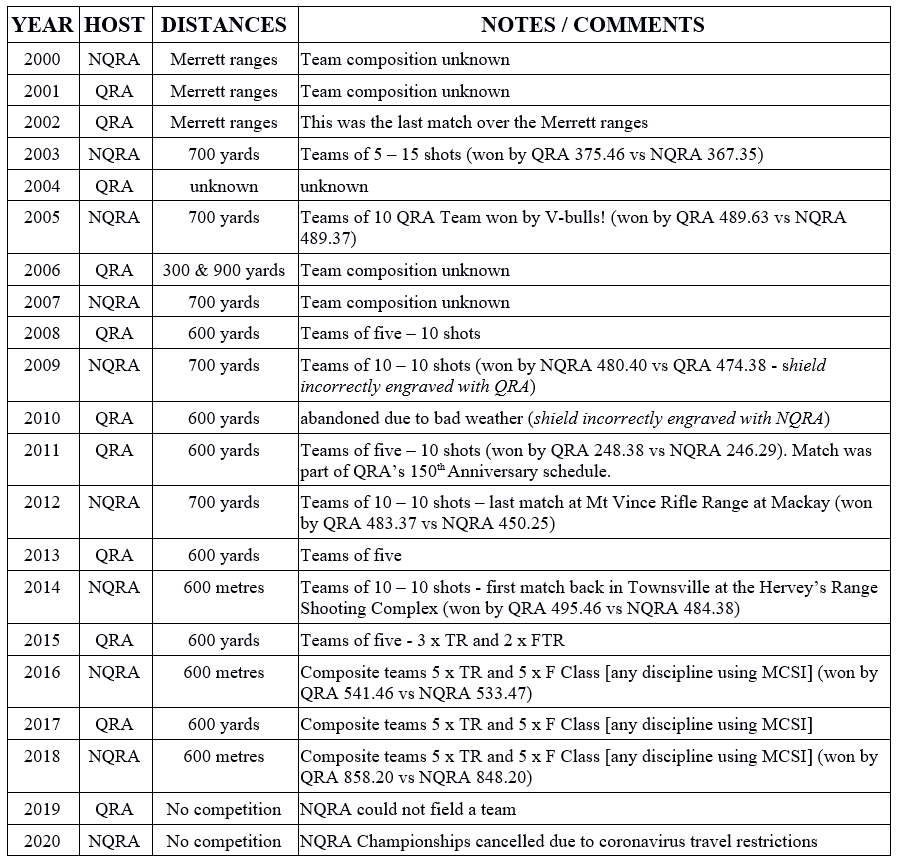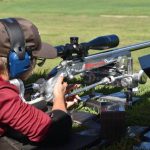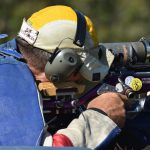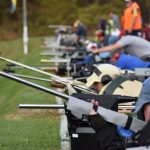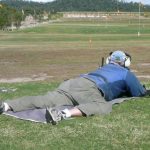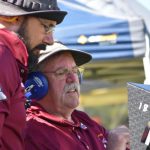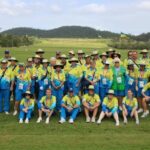Edward Frederick Robert Bage was a member of the Engineers...Read More
WILLIAM FRASER SHIELD
THE WILLIAM FRASER SHIELD
Article by Bruce A R Scott
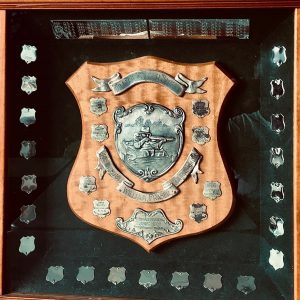 Introduction:
Introduction:
The impressive ‘William Fraser Shield’ was presented by William Fraser while a member of the Cairns Rifle Club. The trophy is awarded for the Inter-Association Teams Shoot – North Queensland versus South Queensland with the first year of competition being 1959. This shield has been contested almost every year for the past 60 years. Unfortunately there are no records readily available within either the North Queensland Rifle Association (NQRA) or Queensland Rifle Association (QRA) that provide an insight into who William Fraser was, why he presented the shield and how the various Fraser Shield team shoots have been conducted since 1959.
The aim of this short article is to record a summary of William Fraser’s life and the history behind the shield. Information used has been predominately obtained from digitised newspapers found in ‘Trove’. The limitation is ‘Trove’ only records papers published up to 1959. It is fortunate that john Mercer (a relative of William Fraser and a NQRA member) recently located a document titled “My Sporting Life as a Rifleman” written by William Fraser in 1978.
William Fraser’s Life:
William Fraser was born at Percyville (83 kms south of Georgetown), Queensland on 2 December 1888 and was the first white child born at the Lower Percy River on a small holding called the ‘Bend’. His life was spent in North Queensland living in towns including Ingham, Mackay, Tully and Cairns and as a consequence he enjoyed target shooting with many NQRA clubs. His early working life was spent as a miner and a drover in remote North Queensland.
He married Bonnie Edmonds (registered name Annie Maria Cogill) on 4 February 1913 and during their marriage they had 10 children and sadly four had died before April 1923. William enlisted in the AIF three times in Mackay, was rejected as being unfit in 1914 and 1915, but was finally successful on 9 February 1918 when it was recorded he had 2 children; 1 aged 3 years and 1 aged 10 months. William was employed by the Mackay District Pioneer Shire Council as a Labourer at the time of his enlistment. During his brief time in uniform, he served with Queensland 2nd General Service Battalion, 9th Training Battalion, 42nd Battalion and 2nd Machine Gun Battalion. While serving in France he became gravely ill, spending a year in hospital. He returned to Australia and was discharged from the Australian Imperial Force (AIF) on 22 June 1919. For his service during the Great War, William was awarded the British War Medal and Victory Medal.
Bonnie and William Fraser lived on the rifle range at Mackay (Barnes Creek, Mt Bassett) from 1925 to 1937 during which time he was employed by the Mackay City Council as a herdsman and was dairying at Mt Bassett on a property they purchased in 1924. While living at the rifle range they had two more children, both sons; Donald born in 1925 and John in 1930. Sadly Bonnie ended her own life through drinking an antiseptic disinfectant called lysol on 14 May 1937. William remained at the rifle range at Barnes Creek until 1943 after which he moved to Tully and in the early 1950s moved further north to Cairns.
A second tragic event impacted the Fraser family. In mid 1952 while William was the caretaker at the Cairns Rifle Range, he was told by Cairns Police that his youngest son, John Fraser (22 years old at the time), had been missing for six months from Devonport Station near Winton, Queensland. On 4 December 1951, John Fraser left the station on horseback with one pack horse to go to a water hole 60 miles away and nothing had been heard of John since he departed. William and John, while they had not seen one another in three years, had kept in touch via three monthly letters. On 31 August 1952 a policeman found the remains of a horse and gear including spurs and a saddle pouch which were later confirmed by John’s older brother, George, as belonging to John Fraser.
Newspaper reports suggest that William Fraser, without family and approaching 70 years of age, moved to the Georgetown – Mt Surprise area in 1957 to pursue his passion of fossicking amongst the region’s tin workings. His only regular companion while living the harsh lifestyle as a fossicker was Dusty Fraser, his dog. His success in finding topaz is credited with creating the Mt Surprise gem fossickers and miners ‘rush’ in 1960. Such was his skill at finding topaz, he was nicknamed Bill ‘Topaz’ Fraser and remained in the region fossicking until the late 1970s when he left his claim at Swampy Creek to move back to Ingham. William died in Cairns on 22 March 1981 having undergone a medical procedure to restore his eyesight and is buried in the New Ingham Cemetery, RSL Section, Plot 1.
William the Target Rifle Shooter:
On 5 June 1906, William Fraser joined the Georgetown Rifle Club when rifle shooting at the time was open sights and double arm slings. His shooting results were so poor in the first six months that he was on the verge of giving up. A school mate lent him a ‘decent’ rifle encouraging him to continue and thus began an enjoyable shooting career.
William wrote that not long after his scores improved that: ‘The club was holding their annual prize meeting and riflemen came from Normanton, Croydon and Golden Gate. The ranges were two, five and six hundred yards.’ William was last down and won 200 yards with 32, then won 500 yards also with 32 and at 600 yards with another 32 to win the range and the aggregate. William wrote ‘and many years afterwards I looked upon this shoot as my best and it kept me in the sport of rifle shooting.’ Sadly, none of the four rifle clubs mentioned above exist today.
William moved to Ingham joining the Herbert River Rifle Club through which he was introduced to the NQRA King’s Prize shoots held then at Easter at the Townsville’s Cluden Rifle Range. He made particular mention of the friendly rivalry that existed between the Herbert River and Halifax Rifle Clubs. He recorded that, while living in Ingham, he purchased his first new aperture rifle sight, a ‘Monty’ made by H. Murch of Ingham, at a cost of 30 shillings ($3).
He then moved to Mirani where, in 1915, he helped form the Mirani Rifle Club before joining the Mackay Rifle Club. William stated ‘I enlisted in Mackay and went overseas and on return I reformed the Mackay Rifle Club which grew into one of the strongest clubs in Queensland. ….In the Mackay District there were ten clubs and a union, I was secretary of the Mackay Club and also the union secretary….’
In 1926 William was actively involved in establishing the Diggers Rifle Club in Mackay. This club was formed under the auspices of the Returned Sailors and Soldiers Imperial League of Australia (RSSILA), and was open to all ex servicemen of the AIF and Empire forces. Newspaper reports suggest William was a member through until May 1940 when the club would have been placed in recess due to the Second World War. A notable fellow member of the club was Fred Zemek who won the 1935 NQRA King’s Prize.
William reported in his notes that ‘I shot remarkably well right up to 1939. For 15 years I attended the King’s Prize Meetings in South Queensland, New South Wales and Victoria. I was always regarded as a very good rifleman.’ Newspaper articles indicate William Fraser was a member of the Tully Rifle Club in 1948 before moving to Cairns in the early 1950s.
During his shooting career, William Fraser wrote that he won six King’s badges, four Union Aggregates, 18 club prize shoots and 15 club championships. He continued to support rifle shooting until he passed away in 1981, nine months short of his 93rd birthday. William Fraser has the rare distinction of being awarded Life Membership of three rifle clubs; Mirani, Mackay and Cairns. The Cairns Rifle Club clubhouse is named the ‘Bill Fraser Memorial Clubhouse’ in his honour.
It appears the original intent of this competition was to mirror the conditions of the National Teams Merrett Match which is contested by State and Territory target rifle teams consisting of a captain, two coaches and 10 shooters. The Merrett Match is shot over four ranges and currently includes distances of 300, 600, 900 and 1000 yards or the metric equivalent. NQRA and QRA has taken turns in hosting the William Fraser Shield competition and generally scheduled it in their respective State Championship programs.
The William Fraser Shield was a very significant event for NQRA members from 1959 until the association became a regular entrant in the National Teams Matches. NQRA was first invited by the National Rifle Association of Australia (NRAA) to enter a team in the National Teams Matches in 1968 but did not become a regular participant in the until 1972. Until 1972, NQRA most skilled marksmen nominated for one or two positions in the Queensland Rifle Team to contest the National Teams Matches annually.
It is therefore surmised that William Fraser identified NQRA’s competitors were lacking team experience and this was not assisting with their aspirations of being selected in the Queensland Rifle Team. In 1959, without prompting, he addressed this lack of team competition by inaugurating a North vs South Queensland annual team event. There was little fanfare attached to the donation of the shield with the NQRA Council Meeting on 3 October 1959 simply acknowledging the delivery of the shield and the match that occurred at the Enoggera Rifle Range that same year. NQRA hosted the 2nd match in 1960 at the Withnall Rifle Range (previously named Cluden Rifle Range) in Townsville.
There is evidence that prior to 1959 there were adhoc ‘challenge’ team matches between the two groups with one scheduled in South Queensland in 1951 and another at Frenchville Range (now closed) in Rockhampton in 1956.
In 1966 there was an unofficial match at the Withnall Rifle Range conducted over 500 and 600 yards for the purpose of identifying NQRA’s talent to be considered in the Queensland Team for that year. While this was noted as an unofficial match, the engraving on the shield suggests it was awarded.
The South Queensland (now QRA) team has dominated this competition since its inception. The shield engraving indicates that NQRA has only won the event on two occasions, being 1963 and 2010. NQRA Council minutes of 19 October 1963 records the 1963 competition, conducted at Enoggera Rifle Range in Brisbane, was abandoned part way through the 600 yards shoot due to the onset of heavy rain. The shield was awarded based upon the highest team aggregate from 300 yards and those team members that completed 600 yards – the NQRA team was awarded the shield. NQRA Minutes of 30 October 2010 Meeting states the 2010 Fraser Shield was cancelled due to bad weather. However the Australian Target Rifle Magazine (July/August 2009, Issue No 81) reports NQRA was victorious for the second time at Mackay during the 2009 NQRA Championships. It would therefore appear the shield’s engraving reflects incorrect results for 2009 and 2010.
The competition has not been without controversy. The NQRA Council Meeting of 7 October 1961 recorded that the match conducted in Brisbane in August 1961 did not adhere to the match conditions and therefore the shield was not presented. No information was recorded as to what conditions were not followed and, of note, the shield is engraved suggesting the QRA team was victorious.
While few detailed records of the William Fraser Shield Match results are available, one published in the NQRA’s newsletter ‘The Crocodile’ (Vol. 1, No. 2 of the September 1979 edition) provides a concise summary of this important NQRA vs QRA teams match and was likely the last occasion that William Fraser was present at the event:
In 2000 the William Fraser Shield was a significant event in the NQRA’s Easter Championship program. On this occasion the shield was contested over 300 yards, 600 yards, 700 yards and 800 metres. Of note, the visiting Scottish Rifle Team competed alongside the NQRA and QRA teams thereby providing an international flavour. The 2002 match, hosted by QRA, was the last year that the event was contested over the Merrett distances. For various reasons, including competition program space, range capacity and marker availability, the team composition and distances contested were modified.
The last 20 years have seen significant changes to the sport of long range target rifle shooting with many aspects of the sport being forced to adapt to survive. Importantly, the growth of the F Class disciplines has demanded its inclusion in all levels of competition. The table below suggests that the William Fraser Shield has not been excluded from the impacts of change on the sport and in some ways has lead the way by adapting the shield’s competition construct. Cooperation, flexibility and innovation have been jointly exercised by NQRA and QRA to ensure the William Fraser Shield competition continues.
Conclusion:
The vision for the sport of long range rifle shooting by previous leadership, at all levels, is often not clearly defined or understood and therefore not acknowledged. Without understanding the sport’s history, the current leadership can not learn from past experiences.
It is therefore important to preserve and publish the history such as that which is behind the William Fraser Shield and acknowledge the foresight William Fraser displayed in establishing such an important annual team match between the North and South of Queensland. North Queensland competitors certainly benefited from having the opportunity of competing in such a team match.
This 60 year old competition has adapted and become inclusive of all long range shooting disciplines to enhance its longevity. The lesson here is other long standing and prestigious competitions may also need to adapt or be modified if they are to be retained for future generations.
Author’s Acknowledgement:
I wish to acknowledge the research effort and support received from John Mercer (Townsville Marksmen Rifle Club, NQRA), Dick Crozier (Sarina Rifle Club, NQRA) and John Caske (Natives Rifle Club, QRA). Their contribution has enabled me to uncover the story behind William Fraser, this historic shield and team shooting competition. Thank you.
Information contained within this article has been gathered from:
- NQRA’s History – ‘So You Went Target Rifle Shooting’ launched on 17 May 2019
- Minutes of the North Queensland Rifle Association Council Meetings 1950-1977
- Various newspaper articles located via TROVE
- Various editions of the Australian Target Rifle magazine 2000 to 2018
- Engravings on the William Fraser Shield
- A document titled “My Sporting Life as a Rifleman” written by William Fraser in 1978 and newspaper clippings from the 1970s held in private collection
HISTORY
ANZAC DAY 2023
We must never forget the sacrifices made by Australians during...Read More
All Queens/Kings Winners
Discover the winners of the QRA Queens Championship from its...Read More
All Queens Winners (TR/B, TR/C)
Discover the winners of the QRA Queens Championships in target...Read More
State Championship Winners – QRA Queens F CLASS
Discover the winners of the QRA Queens Championships in F...Read More
Ladies’ Miniature Rifle Clubs
Ladies' miniature rifle clubs were not only connected with the...Read More
The William Fraser Shield
The impressive ‘William Fraser Shield’ was presented by William Fraser...Read More
QRA LIFE MEMBERSHIP – John (Johnno) Johnstone
The Queensland Rifle Association generally bestows life-membership on recipients about...Read More
ANZAC DAY ADDRESS – 2019
BRUCE A. R. SCOTT, CSC, ADC, ANZAC DAY ADDRESS -...Read More
Percy Pavey
Unchallenged as the greatest competitive marksman Australia has ever produced,...Read More
Downs Identity a Sporting 90
Darling Downs identity Ted Long first took up rifle shooting...Read More
Who doesn’t know Glen Donald Perrin
A QRA member for 70 years and still going. Glen...Read More
QRA Museum
The QRA Museum is located on the Belmont Shooting Complex...Read More
QRA Museum’s 45th Anniversary Display of the Queensland Ladies Rifle Team
QRA Museum’s 45th Anniversary Display of the Queensland Ladies Rifle...Read More
Quick Links
Our Location
Belmont Shooting Complex
- 1485 Old Cleveland Road, Belmont Qld, 4153
- PO Box 38, CARINA QLD 4152
- 07 3398 4309
- qra@qldrifle.com
- Duncan Range Standing Orders - Refer to the office
- Covid-19 Information
- GIVEITASHOT & FSC registration is via RevolutioniseSport management
Quick Links
About Us
The Queensland Rifle Association fosters target rifle shooting and firearms training through our clubs. Different classes of rifle shooting are conducted by our Clubs under the Standard Shooting Rules (SSRs) of the National Rifle Association of Australia (NRAA).
NRAA Quicklinks
Our Location
Belmont Shooting Complex
- 1485 Old Cleveland Road, Belmont Qld, 4153
- PO Box 38, CARINA QLD 4152
- 07 3398 4309
- qra@qldrifle.com
- Duncan Range Standing Orders - Refer to the office
- Covid-19 Information
- GIVEITASHOT & FSC registration is via RevolutioniseSport management
